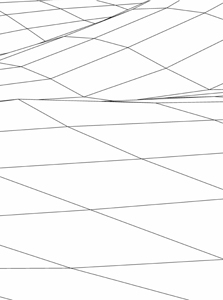Albert Oehlen's collages (artist's book): a spatial and temporal journey into the tradition of artistic representations of domestic interiors, from the great names of art history to the artist's own works.
Coming out in the series STUDIOLO / Edition Patrick Frey,
In der Wohnung is a book about the long-standing tradition of representations of domestic interiors. Since antiquity, painting has played with the motif of the interior: the symbol of depth, evoked by every form of illustration. In his latest collages Albert Oehlen works with source materials drawn from art history, transforming works by the likes of Vuillard and
Dali into
pop art “panels”.
It is a journey through time that begins in a landscape in which the viewer comes across works from Oehlen's oeuvre referring to paintings by Thomas Arnolds, Richard Artschwager,
Mike Kelley,
Martin Kippenberger, Roy Lichtenstein
et al. Then we see a building in the landscape, rooms inside that building, and we have arrived for a tour of the Albert Oehlen exhibition
In der Wohnung.
Published following a collective eponymous exhibition with Albert Oehlen, Fredi Fischli and Niels Olsen in the Spring of 2014 at the Gebert Stiftung für Kultur in Rapperswil-Jona, Switzerland.
Awarded: “Most Beautiful Swiss Books 2015”.
Albert Oehlen's (born 1954 in Krefeld, Germany) oeuvre is a testament to the innate freedom of the creative act. Through expressionist brushwork, surrealist methodology, and self-conscious amateurism he engages with the history of abstract painting, pushing the basic components of abstraction to new extremes.
Oehlen studied at the Hochschule für bildende Künste Hamburg in Germany from 1978 to 1981 and quickly rose to prominence in the Berlin and Cologne art scenes. He came to be associated with the Junge Wildeartists, including
Martin Kippenberger and Werner Büttner, who sought to create work that defied categorization and refuted the artistic status quo. Straddling various debates surrounding the nature of painting, Oehlen's work deconstructed the medium to its constituent elements—color, gesture, motion, and time—and evolved out of constraints he applied to his artistic process. This line of investigation, which Oehlen has continued to pursue in the decades since has resulted in striking variations between—from works that combine abstract and figurative styles, created in response to the Neo-Expressionism of the 1980s, to paintings comprising of grids of colored squares.
As Oehlen began to incorporate new technologies into his work—inkjet printers, computer-aided design programs, and references to the pixelated lines of computer screens—the parameters that he set for himself shifted, offering new obstacles and challenges. Some of these self-imposed "rules" include limiting his palette and combining perambulating black lines with carefully blended gradations (in the
Baumbilder [
Tree Paintings]), and utilizing erasure and layering to juxtapose bright and muddy colors, as in the
Elevator Paintings, a single work in nine parts from 2016. In the late 1990s, Oehlen spray-painted over collaged imagery that had been transferred to canvas with large, industrial printers typically used to create billboards.
Oehlen is perhaps best known for his embrace of "bad" painting. Alongside his many rules, he allows a certain awkwardness or ugliness to enter his work, introducing unsettling gestures, crudely drawn figures, visceral smears of artificial pigments, bold hues, and flesh tones. In this way, he attests to the infinite combinations of form made possible through painting, and shows that these combinations can be manipulated at the artist's will to produce novel perceptual challenges for the viewer.
See also
Wendy Gondeln (Albert Oehlen).














